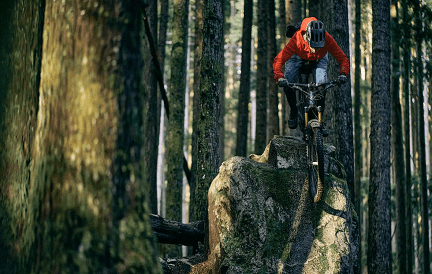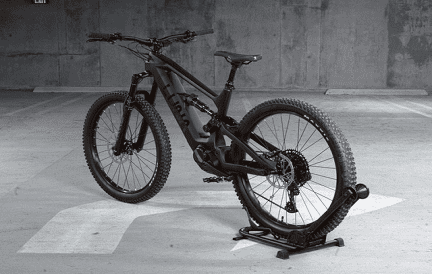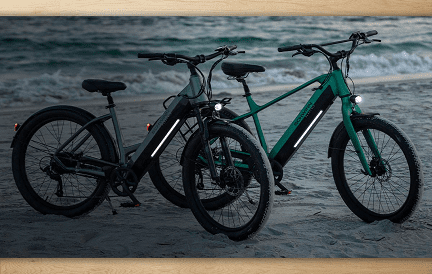Whether you’re a male or female mountain biker, we’ve got you covered in this guide. Mountain biking is an incredible sport, whether it’s 29ers or 27.5 or 650b. We have the information on mens mountain bike sizing that you need to get on a bike and start riding.
- Part 1: Finding the Right Mountain Bike Size
- Part 2: How to Find a Mountain Bike Size That Fits You
- Part 3: Mountain Bike Stand over Height
- Part 4: Mountain Bike Frame Size Chart
- Part 5: Determining Your Height and Inseam
- Part 6: Deciding on a Wheel Size
- Part 7: Narrowing Down Your Bike’s Style
- Part 8: Sizing Tips for Men’s Mountain Bikes
- Part 9: Conclusion
Part 1: Finding the Right Mountain Bike Size
Mens mountain bikes come in standard sizes (S, M, L), which usually correspond to your height. Many bike manufacturers include size charts that list the height ranges for each bike size. (If you’re in between, it’s best to err on the smaller side, as smaller frames offer more size adjustment than too-large frames.) Finding the right mountain bike size is not always a simple task. Before you head out to the shop, make sure you know what size bike fits you and why it’s important.

If you are buying an off-the-shelf bike, this will be easy. But if you are planning on building your own or buying a custom frame, then knowing how to measure yourself is key.
What is Correct Mountain Bike Sizing
The first thing to do when trying to find the right mountain bike size. Because it is to figure out the length of your inseam. This refers to the distance from your groin to the floor with shoes on. The average male inseam ranges from 27″ to 30″. However, there can be quite a variance depending on body type and height. So it may be useful for you to measure yourself before heading out for your next ride!
Part 2: How to Find a Mountain Bike Size That Fits You
Mountain bikes are designed to be ridden on rough terrain, so they have a different geometry than road bikes. If you’re used to riding a road bike, you may need some adjustments in order to find a mountain bike size that fits you. Here are some tips:
- Stand over height: Stand over the top tube with your feet flat on the ground. The distance from your crotch to the ground should be about one inch less than the distance from the top of your seat to your crotch. This helps keep you from scraping your knuckles when you ride over rough terrain.
- Seat height: Sit on the seat and crank down on the pedals until there’s no slack in the chain and then measure how high off the ground your foot is (with shoes on). You want it to be about an inch below where it would be if you were standing up. That way, when you pedal down hills, your knees won’t hit them — or worse yet — bend them back while they’re bent forward at an awkward angle!
The Importance of Bike Fit
If you’re shopping for a new mountain bike, you’ll want to know about mens mountain bike sizing. Bike sizing is important because it can make or break your riding experience. If you get the wrong size bike, it will be uncomfortable to ride and unsafe. If you get the right size bike, then it should be comfortable and safe.
The first step in getting the right bike is to figure out what size frame you need. Mountain bikes come in all different sizes, so knowing what size frame you need is important when shopping for one. If the frame is too big or too small, then it’s not going to fit properly and it could cause injury.
There are two main factors that go into mens mountain bike sizing: weight and height. You’ll want to know about both of these things when shopping for your next mountain bike so that you can find one that fits correctly and feels good on your body type.
Part 3: Mountain Bike Stand over Height
Mountain bikes come in a variety of sizes and shapes, but when it comes to the stand-over height, you’ll want to make sure that your mountain bike fits properly.
In this article, we’ll help you determine what size mountain bike is right for you. We’ll also give you tips on how to choose the correct stand-over height so that your new mountain bike is comfortable and safe.
What Is Stand over Height
Standover height is the distance between the top tube of your bike and the ground when you’re straddling your bicycle. It’s measured from the center of the tire to the top tube of your bike frame. For example, if you have 17-inch tires on your mountain bike and they sit three inches off of the level ground when inflated, then your stand-over height would be 16 inches (17 x 3 = 51 + 17 = 68).
Why Does Standover Height Matter
Standover heights are important because they affect how easy or difficult it will be for you to get on and off your mountain bike. If there isn’t enough clearance between your body and the Seatpost. You may not be able to get up onto or down from your bicycle without hitting yourself on either one or both items before starting riding again.
Part 4: Mountain Bike Frame Size Chart
A mountain bike is a type of bicycle that is for use off-road, often on rocky trails. Mountain bikes share similarities with other types of bikes such as road and track racing bicycles. But are generally heavier due to the robust construction needed to withstand the stresses of off-road use.
Mountain bike sizes vary with frame geometry, riding style and rider height. However, seat tube lengths are generally around 16 inches to 20 inches (40–50 cm) for a typical mountain bike frame. The distance between pedal cranks is 2 feet 6 inches (76 cm) or more, which allows riders to comfortably straddle the bicycle when riding. This measurement is called reach and it can vary greatly between different models.
The length of a bicycle’s top tube is also important because it will affect how much legroom there is when sitting in the saddle. How high one’s torso is above the handlebars and how far forward or back one may be positioned when climbing hills or mountains.
Part 5: Determining Your Height and Inseam
Mens mountain bike sizing is a simple process of determining your height and inseam. But there are some considerations that can help you get the perfect fit for your new steed.
In order to find out what size mountain bike you need, follow these steps:
Measure Your Height
Stand up straight with your back against a wall. Use a measuring tape to find out how tall you are. If you don’t have one handy, then use a piece of string or ribbon that is marked in feet and inches.
Measure Your Inseam
With your shoes on, measure from your crotch to the floor. This will give you an idea of how long your legs are and what size seat post you need for your new bike.
Part 6: Deciding on a Wheel Size
Choosing a wheel size is one of the most important decisions you’ll make when buying a mountain bike. The wrong choice can lead to a bike that doesn’t fit, changes your riding style, and ruins your experience. The most common wheel sizes are 26 inches (700c), 27.5 inches, and 29 inches. There are also plus-sized wheels in 27.5+ or 29+. We’ll look at each of these sizes in more detail below.
26 Inch Wheels
26-inch wheels were once the dominant wheel size on mountain bikes but have lost ground in recent years to larger wheels. They still represent about 60 percent of all bikes sold today. But it’s likely that number will continue to decrease as more riders opt for larger wheels that roll over obstacles easier and faster.
Pros: 26-inch wheels offer good acceleration and climbing ability, especially with smaller tires installed on them. They’re also lighter than larger wheels and easier to replace if damaged in an accident or crash (which happens more often when riding trails).
Cons: 26-inch wheels can be difficult to handle on technical terrain because they don’t roll over obstacles as easily as larger tires do.
Part 7: Narrowing Down Your Bike’s Style
The final piece of the puzzle is choosing a bike style. The good news is that mountain bikes come in a variety of styles. So you can find something that fits your riding style. If you’re new to mountain biking, the best way to narrow down your choices is to focus on these three categories:
Trail Bikes (All-Mountain)
The designers make the trail bikes for riding on wide dirt trails and smooth fire roads. They have wider tires and suspensions that are tuned for comfort over rocky terrain. Because they can handle more varied terrain than other types of mountain bikes, trail bikes are great for beginner riders who want to get into the sport without spending too much money on equipment. Trail bikes tend to be heavier than other styles because they’re for comfort over speed. But if you’re looking for a bike that can handle everything from rooty singletrack rides to long cross-country rides, a trail bike would be an excellent choice.
Enduro Bikes (Downhill)
Enduro bikes are specifically for downhill racing. They tend to have stiffer frames and components so they don’t move around as much when negotiating rough sections of trail at high speeds.
Part 8: Sizing Tips for Men’s Mountain Bikes
Tips for Male Kids and Youth
Choosing the right size mountain bike for your child is an important decision. Not only does the bike need to fit properly, but it must be comfortable to ride and durable enough to withstand abuse from kids.
We’ve put together this mens mountain bike sizing guide. It can help you find the perfect mountain bike for your child or teen.
The first section covers basic mountain bike sizing information, while the second part will provide tips on how to choose a good fitting bike for your child based on riding style and height. If you’re looking for specific recommendations, feel free to jump down to our reviews section where we cover our favorite kids’ bikes.
Tips for Adult
There are many factors that can affect the right size mountain bike for you. These include your height, weight, and experience level, as well as the type of terrain you plan to ride. If you’re just starting out, it’s best to choose a bike that’s slightly larger than you need, so that you have room to grow into it.
When selecting a bike size, it’s important to remember that your seat height plays an integral role in getting the correct fit. Different manufacturers use different measurements for mens mountain bike sizing their bikes. Some measure from the center of the crank arms to the top of the seat tube (TTST). While others measure from the center of the bottom bracket axle (BBST). The TTST measurement is more common on newer bikes because it allows for more frame options when riders are looking for both long and short frames.
Part 9: Conclusion
Mountain bike sizing is different from road bike sizing. The designers design the mountain bikes with 26-inch wheels and tires to handle rugged terrain and obstacles.
If you are buying a new mountain bike, it is important that you get the right size. As with road bikes, there are different sizes available for men and women, but they are not as large as they are with road bikes. There are also different types of mountain bike frames and styles to choose from.
The average mountain bike frame for men is between 16 inches and 20 inches in height. The ideal height for a frame on a man’s mountain bike is between 17 inches and 18 inches tall. This will give him enough space to ride comfortably without feeling cramped or too large for his bike. If your budget allows it, consider getting a custom-built frame that will fit perfectly at your preferred height.








